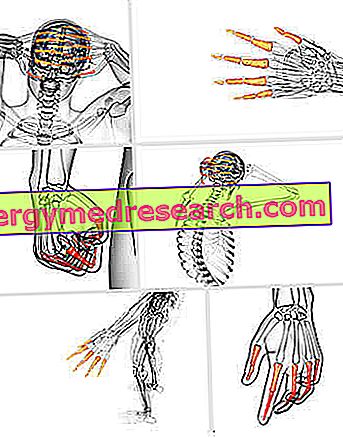Generality
A phalanx is one of the 14 bones, which, in each hand and in each foot, make up the skeleton of the fingers and constitute the most distal anatomical portions of each upper and lower limb.

In both hands and feet, the first finger - which, in the hand, is the thumb and, in the foot, the big toe - consists of 2 phalanges, while all the remaining fingers of 3.
The phalanges closest to the metacarpals / metatarsus are called first phalanges (or proximal phalanges); the phalanges following the first phalanges are called second phalanges (or intermediate phalanges); finally, the phalanges that come after the second phalanges are known as third phalanges (or distal phalanges). Clearly, in the thumb and big toe, this numbering ends with the second phalanxes (which, on this occasion, take the wording of distal phalanges).
In a generic phalanx can be distinguished three main portions, which are: the body, the proximal end and the distal end.
Articulated to each other and to the metacarpals / metatarsals, the phalanges give insertion to the terminal heads of some important muscles of the hand and foot.
Like any bone in the human skeleton, even the phalanges can fracture.
What is a phalanx?
A phalanx is one of the 14 bones, which, in each hand and in each foot, form the skeleton of the fingers and represent the most distal portions of each upper and lower limb.
In each hand, the 14 phalanges are added to the 5 metacarpals (or metacarpal bones ) and to the 8 bones of the carpus (or carpal bones ); in each foot, instead, they are added to the 5 metatarsals ( or metatarsal bones ) and to the 7 bones of the tarsus (or tarsal bones ).
Overall, the human body comprises 56 phalanges (28 equally divided between the two hands and another 28 equally divided between the two feet).
Review of the meaning of the terms proximal and distal
Proximal and distal are two terms with opposite meaning.
Proximal means "closer to the center of the body" or "closer to the point of origin". Referring to the femur, for example, it indicates the portion of this bone closest to the trunk.
Distal, on the other hand, means "farther from the center of the body" or "farther from the point of origin. Referred (always to the femur), for example, it indicates the portion of this bone furthest from the trunk (and closer to the knee joint).
Anatomy

The group of phalanges represents the distal skeletal portion of each hand and each foot. In fact, in order of proximity, the group of metacarpals / metatarsals (intermediate skeletal portion) and the group of carpal / tarsal bones (proximal skeletal portion) come after.
In both hands and feet, the distribution of the 14 phalanges includes: 2 phalanges, for the first finger (thumb, in the hands, and big toe, in the feet) and 3 phalanges, for each of the remaining fingers.
By convention, the phalanges closest to the metacarpals / metatarsus are called proximal phalanges or first phalanges ; those immediately following the first phalanges are called intermediate phalanges or second phalanges ; finally, those placed immediately after the second phalanges are known as distal phalanges or third phalanges (NB: in the thumb and big toe, clearly, the numbering of the phalanges stops at the second phalanges, which on this occasion take the name of distal phalanges) .
BONE ANATOMY OF THE FALANGES
In each phalanx, three bony portions are distinguishable, which are:
- The so-called body ;
- The so-called proximal or base end ;
- The so-called distal end or head ;
The body of a phalanx is the central bony portion, between the proximal end and the distal end; in general, it is concave, from the palmar part (or plantar, in the case of the feet), and convex, from the dorsal part.
The proximal (or base) end of each phalanx is the bone portion that articulates with the bone of the hand or foot immediately preceding it. In the first phalanges, it is an oval region presenting a single concavity, within which the head of the metacarpus / metacarpus that precedes it is housed; in the second phalanges and in the third phalanges, instead, it is a region presenting a double concavity and having the task of housing the distal end of the immediately preceding phalanx.
Finally, the distal end (or head) of each phalanx is the terminal bony portion, which in the first and second phalanges also represents the point of contact with the proximal end of the immediately following phalanges.

JOINTS
The phalanges of hands and feet take part, depending on the position they occupy, at one or two joints .
Specifically, each first phalanx participates in:
- The joint that joins its proximal end with the head (distal end) of the metacarpal / metatarsal immediately preceding
is
- The joint that connects its distal end with the proximal end of the second phalanx.
Every second phalanx gives life to:
- The joint that joins its proximal end to the distal end of the second phalanx.
is
- The joint that joins its distal end to the proximal end of the third phalanx.
Finally, each third phalanx is the protagonist of a single joint, the one that puts together its proximal end with the distal end of the second phalanx.
From the point of view of the denomination, the joints that bring together the first phalanges to the metacarpals and the joints that join the first phalanges to the metatarsus take the name, respectively, of metacarpophalangeal joints and metatarsophalangeal joints ; the joints joining the first and second phalanges, both in the hands and in the feet, are known as proximal interphalangeal joints ; to finish, the joints that join the second to the third phalanges, always both in the hands and in the feet, are better known as distal interphalangeal joints .
MUSCLES THAT HAVE RELATIONSHIPS WITH THE FALANGES OF THE HAND
Some phalanges of the fingers of the hand attach to the terminal ends of several muscles of the hand .
In fact, on them find insertion:
- The common extender of the fingers of the hand . This muscle ends its path, in part, on the second phalanges and, in part, on the third phalanges of the index, middle, annular and little finger;
- The author of the index . This muscle concludes its path, in part, on the second phalanx and, in part, on the third phalanx of the index;
- The extender of just the smallest finger (or little finger) . This muscle is inserted, in part, on the second phalanx and, in part, on the third phalanx of the little finger;
- The short extensor of the thumb . This muscle ends its course on the first phalanx of the thumb;
- The long extender of the thumb . This muscle concludes its path on the second phalanx of the thumb;
- The flexors of the fingers of the hand . There are a total of 8 and they are subdivided into superficial and deep. The superficial ones terminate on the second phalanges of the fingers (excluding thumb); the deep ones, instead, end on the third phalanges of the fingers (excluding thumb);
- The muscles of the tenar eminence known as: short abductor of the thumb (first phalanx of the thumb), short flexor of the thumb (first phalanx of the thumb) and adductor of the thumb (first phalanx of the thumb);
- The muscles of the eminence hypotenar known as: abductor of the minimum finger (first phalanx of the little finger) and flexor of the minimum finger (first phalanx of the little finger);
- The volatile interosseous (or palmar) and dorsal muscles of the hand . Both these classes of muscles end their path on the first phalanx (clearly in distinct areas) of the index, middle and ring fingers.
MUSCLES THAT HAVE RELATIONSHIPS WITH THE FEET OF THE FEET
Just like certain phalanges of the fingers of the hand, even some phalanges of the toes host the terminal heads of various muscles of the foot .
Among the muscles of the foot that have relations with the phalanges of the same part of the body, fall:
- The long extensor of the big toe . Its course ends on the dorsal side of the base of the distal phalanx of the first finger;
- The long flexor of the big toe . Its terminal head is inserted on the plantar side of the base of the distal phalanx of the first finger;
- The short extensor of the big toe . Its terminal head is attached to the base of the proximal phalanx of the first finger;
- The abductor of the big toe . Its terminal head is attached to the base of the proximal phalanx of the first finger, precisely on the medial face;
- The extensor along the toes . It's a muscle with more terminal ends. These terminal heads make contact with the intermediate and distal phalanges of the second, third, fourth and fifth fingers;
- The short extensor of the toes . It is a muscle with 3 different terminal heads. These 3 terminal heads are anchored at the level of the intermediate phalanges of the second, third and fourth fingers;
- The short flexor of the big toe . Its terminal head finds insertion in a medial portion of the first phalanx of the big toe;
- Hallux adductor . Its terminal head is inserted into a lateral portion of the first phalanx of the big toe;
- The abductor of the minimum finger (or fifth toe ). Its course ends at the base of the proximal phalanx of the fifth finger, on the lateral face;
- The short flexor of the minimum finger . Its path ends on the first phalanx of the fifth toe;
- The short flexor of the toes . It's a muscle with more terminal ends. These terminal heads find insertion on the middle phalanxes of the second, third, fourth and fifth fingers;
- The lumbrical muscles of the foot . Their path ends at the first phalanges of the toes, except toe;
- The interosseous dorsal and palmar muscles of the foot . Their path ends on the first phalanges (clearly in distinct sites) of the second, third, fourth and fifth toes.
Functions
Each phalanx is a fundamental part of the skeleton of hands and feet.
Furthermore, some of them also have the important task of inserting muscles indispensable for the correct functionality of the aforementioned anatomical parts (eg, flexion or extension movements of the fingers or toes, etc.).
It should be remembered that, in the human being, hands allow to grasp objects, they act as tactile organs, they are instruments of communication and guarantee stability to the movement, at an early age; the feet, on the other hand, guarantee stability to the upright position, absorb much of the body's weight and allow locomotion (eg: walking, running, jumping and walking on uneven surfaces).
clinic
Like all bones in the human body, the phalanx of a hand or foot can also be fractured .
FRACTURE OF A HAND FALANGE
As a rule, the fractures of one or more phalanges of the hand are minor injuries (that is, not very serious), which generally occur following traumatic events that damage the fingers of the hand (eg: crushing of a finger). In general, the treatment of fractures on a phalanx of the hand simply involves a period of rest of the affected hand of about 3-4 weeks and the application of ice on the painful area, several times a day (especially in the first period).
In the rare event that a fracture of the phalanx of the hand is particularly severe, the surgeon may need to be involved to encourage correct bone fusion.
FRACTURE OF A FOOT FALANGE
Like fractures of a phalanx of the hand, even fractures of one or more phalanges of the foot are, in general, injuries of modest severity, which result from trauma to the fingers.
Usually, the treatment of fractures of a phalanx of the foot involves a rest period of the affected foot of about 20-30 days and the application of ice on the painful area, several times a day (especially in the first period).
In the remote case where a fracture of the phalanx of the foot is very severe, surgery may be essential.



